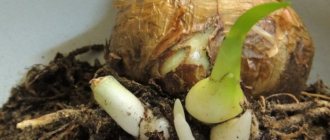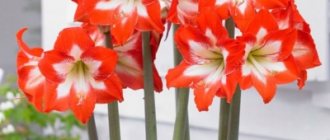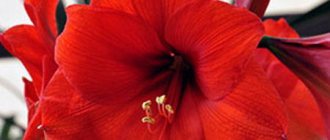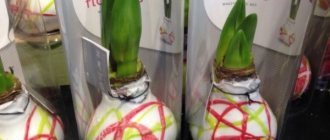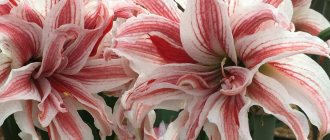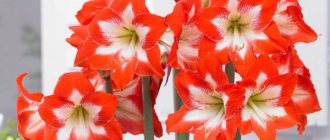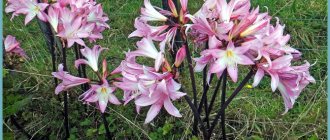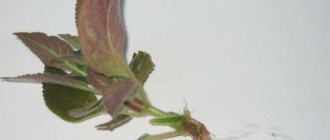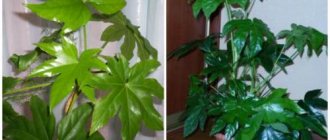Amaryllis is a bulbous flowering plant of the same family. Perennial. Homeland - Olifants River Valley in southern Africa. The distribution area is quite wide. The plant is found in South Africa, Australia, and Japan.
The name of the flower is associated with the famous ancient Roman poet Virgil. Amaryllis, a beautiful shepherdess, appears in his works. From ancient Greek the name is translated as sparkling.
Description of amaryllis
Dark green smooth long leaves are arranged in two rows. The shape is similar to a narrow belt. Inflorescence of an umbrella type.
The root system is a large round bulb, slightly flattened on the sides. Diameter - 5 cm. It is covered with grayish scales, and a dull white rhizome grows from the bottom. The bulb retains its viability for 10–15 years.
The flowering period begins in mid-spring. Duration – 1.5 months. Initially, a fleshy peduncle 0.6 m tall is formed. An inflorescence resembling an umbrella is formed at the top. The shape of the 6-petal flowers resembles a bell. Color: white, cream, pink, yellow, purple-red. In the center there are long stamens and the ovary.
After flowering, fruit boxes are formed, containing more than 6 seeds. They ripen in 30 days.
Choosing a pot
A pot for planting amaryllis should be made of ceramic or clay - durable material will prevent the plant from tipping over during the flowering period, ensuring its stability. In addition, plant roots in containers made of natural materials receive more air and cope with excess moisture more easily.
Photo: pots for amaryllis should be made from natural materials
The pot should be high, and its diameter should be selected in such a way that no more than 2 cm from the location of the bulbs remains to the edge of the container. If you take a more spacious pot, the plant will begin to divide intensively, forming children; in this case, you may not wait for flowering.
Distinctive features of amaryllis
Amaryllis and hippeastrum are often confused. Both plants belong to the same biological group. The genus Hippeastrum is more numerous. It has approximately 90 species found naturally.
The differences between them are presented in the table:
| Comparison sign | Amaryllis | Hippeastrum |
| Bloom | Aug. Sept. | February March. |
| Aroma | It shows up clearly. | Absent. |
| Flower size (diameter in cm) | 10-12 | 6-8 |
| Number of flowers | 4-6. Occurs 12. | 2-4. Maximum – 6. |
| Color | From white to burgundy, there are shades of pink. | Snow-white, lilac, yellow, purple, light green. Variable combination of colors. |
| Presence of leaves in the flowering phase | None. Resume growth after fertilization. | Present. |
| Peduncle | Dense, without voids. Length 0.4-0.6 m. Has a purple tint. | Green hollow tube 70 cm long. Makes a slight cracking noise when pressed. It has a grey-brown color. |
| Bulb shape | Pear-shaped. Covered with gray scales. | Round, elongated at the bottom, slightly compressed on the sides. |
| Motherland | Africa. | South America. |
Root rot or fusarium
It develops against the background of a lack of plant nutrition or sudden temperature changes. When the disease occurs, the flower begins to dry out and fade. To save it, you need to dig up the bulb and treat it with Fundazol. The dried plant is planted in new soil.
In addition to diseases, amaryllis can be affected by various pests - we list them:
- thrips. Small brown bugs that become active on the leaves of the plant. As a result, the leaves begin to turn yellow and dry out until the flower dies completely. The fight against thrips consists of washing the flowers with warm water, treating them with Fitoverm and replanting them in new soil;
- mealybug. Looks like white cotton balls. It affects stems, leaves, roots, covering them with mucus. To destroy the scale insect, plants are wiped with a damp sponge and then treated with any insecticide;
- spider mite Causes the plant to wilt. It can be identified by the characteristic white cobwebs on the leaves. The fight consists of treating with insecticidal preparations, for example, “Oberon”, “Kleschevit”;
- amaryllis mealybug. Settles in the flower bulb, completely blocking the growing season. Treatment consists of removing all damaged areas followed by treating the bulb with an insecticide;
- aphid. Pests that feed on flower juices. The presence of aphids is indicated by curling and yellowing of the leaves. Aphids can be easily destroyed by washing the leaves of the plant with a sponge soaked in a soap or insecticidal solution.
Types and varieties of amaryllis
For a long time, amaryllis was considered a plant of the same type. Now there are two main types of decorative flowers:
| View | Description |
| Amaryllis belladonna | Develops from elongated, round, pear-shaped large bulbs. Green stem 0.5 m high. Has a pleasant, delicate aroma. Belladonna blooms in winter and goes dormant in summer. |
| Amaryllis Paradisicola | It differs in the number of inflorescences: there are 21 of them. It has a pungent odor. Pink flowers. The saturation of the shade increases as the buds open. It has not become widespread in indoor floriculture. |
Based on these species, breeders have developed new varieties. They are distinguished by color, shape, size of flowers:
| Variety | Flower |
| Durban | It is shaped like a bell. Red with a light spot at the base. |
| Parker | Pink with a yellow center. |
| The Snow Queen | Snow-white glossy flowers with a beige edge. |
| Faith | Light pink with a pearly finish. |
| La Paz | Green with red border. |
| Macarena | Terry purple with white stripe. |
| Minerva | Variegated striped petals. |
| Grandior | Gradient transition from soft pink to a more saturated shade. |
You can get an unusual hybrid yourself. During flowering, pollen is collected from the stamens of one variety and transferred to another species. From the obtained seeds, a new variety is grown that combines the parental color.
Caring for amaryllis at home
Amaryllis is more capricious in its contents than hippeastrum. Breeding depends on the period in which the plant arrives.
| Conditions | Vegetation phase | State of rest |
| Flower location | South side. Shading from direct sunlight. | Dark, cool place. |
| Lighting | Bright diffused light 16 hours a day. | Not required. |
| Watering | Use settled water. Water twice a week. Before flowering, slightly moisten the buds. Optimal humidity is 80%. | Watering is stopped. The soil is sprayed. Humidity in the place of detention is 60%. Watering is resumed when the peduncle reaches a height of 12 cm. |
| Ventilation | Keep in a well-ventilated area without drafts. | |
| Temperature | During the day +22…+24 °C, at night +18 °C. Sudden temperature changes are not allowed. | +10…+12 °C constantly. |
| Feeding | Once a decade. Fertilizers – Emerald, Agricola, Kemira. In the flowering phase, apply once every 5 days. Preference is given to fertilizers with a high content of potassium and phosphorus. | Not used. |
Features of planting amaryllis
The first stage is choosing a flower pot. A stable, massive container is suitable for amaryllis. The diameter depends on the size of the planting bulb.
A deep pot with a wide bottom tapering at the top is considered optimal. The next stage is soil preparation.
The purchased soil mixture for bulbous plants is processed:
- pour boiling water;
- put in the freezer for a day.
Prepare the substrate for amaryllis yourself. To do this, mix garden soil, turf soil, humus, peat, and river sand in equal proportions. A layer of drainage made of expanded clay, pebbles, gravel, and brick chips is placed at the bottom.
For planting, use high-quality material: bulbs without cracks, dents, signs of fungal diseases, mold, or a sweetish smell. Disinfection is carried out in a solution of hydrogen peroxide, potassium permanganate, Bordeaux mixture, and dried for a day.
The prepared substrate is poured up to half the pot. Place the onion, leaving a third part above the ground. The soil is compacted, moistened abundantly, and placed in a sunny window.
Hippeastrum is transplanted after flowering. Interval – 3 years. A week before the planned time, the plant is well watered.
The flower along with a lump of soil is removed from the pot. Shake off, inspect the root system, remove rot. Children are separated from the bulb and used as independent planting material.
Amaryllis transplant
Long-acting mineral fertilizer is added to the soil. Agricola is most often used. The remaining manipulations are performed as during landing. Every year, a 4 cm thick layer of soil is removed. Fresh substrate is added to the previous level.
Flowering and dormant periods
When the natural flower drops, the top of the stem is cut off. Nutrient substances accumulate in the root system. The peduncle turns yellow. It is then removed with a sharp knife. After this treatment, new leaves grow. During this period, the plant is well watered and fed.
At the end of summer, moisture is gradually reduced and fertilization is stopped.
The leaves become soft and yellow. In late autumn, the indoor flower is placed in a dark place. The period of refrigeration is 75 days. After this, the plant will bloom again.
With the onset of the dormant period, the bulb is stored in a dark room at a constant temperature of +10...+12 °C. The plant is not watered until the leaves bloom. No fertilizing is used.
Problems with leaves
Most often, when growing amaryllis at home and in the garden, you can encounter a number of problems. All problems have their own causes and their treatment is individual in each case.
Why do they turn yellow?
There are two reasons why leaves turn yellow:
- excessive soil moisture;
- attack of parasites - thrips or aphids.
It is necessary to reduce the frequency and abundance of watering, and also to treat pests.
Important! Drying leaves may indicate the plant is entering a dormant period. In this case, you need to completely stop watering the amaryllis and wait until its above-ground part dries completely. When the leaves dry out, cut them off.
They turn pale
Most often this problem occurs:
when choosing the wrong pot;- due to lack of good drainage in the soil.
There must be large holes in the bottom of the pot so that when watering, excess water goes into the pan. Good drainage is one of the most important stages of planting ; it is this that allows moisture to pass through the soil faster and helps it to be evenly distributed, thereby preventing stagnation of water and excessive waterlogging of the soil.
Darken or rot
Darkening and even rotting of leaves develops due to:
- high level of air humidity;
- lack of heat in the room;
- overwatering amaryllis.
To avoid the problem, you need to move the container with the plant to a drier and warmer room. The permissible humidity level for this indoor flower is 40-50%. Also, when watering, you need to make sure that no moisture gets on the amaryllis leaves .
For all flower growers who appreciate the beauty of amaryllis, there are other materials on our website:
- Arrangement and meaning of bouquets with amaryllis.
- How to care for a flower in winter?
- The cheapest and most popular varieties of amaryllis, as well as a description of the Belladonna variety.
Reproduction
The culture is propagated in two ways:
- seeds;
- vegetatively.
To obtain seed material, cross-pollination is carried out. This is not difficult to do. Pollen is transferred from one flower to another. After opening the fruit boxes, the seeds are collected, which remain viable for 1.5 months.
Propagation by seeds
The containers are filled with nutrient soil. The soil is well moistened. The seeds are planted 5 mm deep and covered with polyethylene. When two true leaves appear, the seedlings dive. The color is formed after 7 years.
When propagated vegetatively, plants retain varietal qualities. Flowering begins in the third year.
Reproduction methods:
| Way | Carrying out |
| Children's department | Planting small rooted bulbs. Initially, the foliage is not pruned: nutrients accumulate and are preserved. |
| Bulb division | The selected planting material is divided into parts. The sections are sprinkled with ash. The parts are placed in sand and kept for 30 days at a temperature of +27 °C. With the appearance of two true leaves, they are planted in a high-quality substrate. |
The poisonous amaryllis bulb can cause skin irritation, so wear protective gloves when working.
Other troubles
There are also problems associated with amaryllis flowers.
The plant does not bloom
This indoor plant may not bloom for a number of reasons:
- lack of lighting;
- lack of soil nutrition;
- the bulb is buried too deeply in the ground;
- any root disease develops;
- the flower did not go dormant this year;
- the plant has not been replanted for a long time and it requires separation of young bulbs.
Reference! If amaryllis is grown from a seed, it will bloom no earlier than after 7 years, and from a bulb it will bloom in the 3rd year.
Read about why amaryllis may not bloom and how to solve this problem.
Petals become lighter
This reason occurs when a flowering plant is exposed to direct sunlight for a long time. To avoid fading of the petals, you need to place the flower pot on the south-eastern or south-western windows, and shade the amaryllis on very hot days.
Problems when growing amaryllis
Easy to care for, amaryllis can sometimes cause some difficulties:
| Problem | Elimination methods |
| Stunting | Check the condition of the bulb. Lack of development within 30 days after planting indicates its non-viability. |
| No flowering | Summer vacation, landing in a sunny place. |
| Premature wilting of leaves | Application of fertilizers. |
Why does amaryllis not bloom, but only produce leaves?
Quite often, flower growers are faced with a problem when their amaryllis does not bloom, but, although looking healthy and developing normally, only produces leaves. The main reason that the plant does not form flower stalks is improper care and unsuitable conditions.
It is important to familiarize yourself with common mistakes that lead to lack of flowering and how to correct them:
| Cause | Solution |
| Bad light | Move the crop to a brighter area. An excellent choice would be eastern or western window sills. |
| Lack of nutrients in the soil | Do not forget to feed the soil with liquid fertilizers for bulbous ornamental crops. |
| Dense soil that prevents normal root growth | Transplant the bulb into a looser earthen substrate. |
| Low room temperature, which inhibits crop growth | Keep the flower in a room where the air temperature does not fall below 20 °C. |
| A small pot, the entire space of which was filled with bulbous children. | Plant the young bulbs in separate containers. |
| The onion was not provided with rest | Allow the bulb to rest by placing it in a cool, dark place. |
| The bulb is too deep in the soil | Replant the bulb, following all planting rules. |
| The plant is affected by diseases or pests | Regularly inspect the crop for diseases and pests. |
However, poor plant care is not necessarily the reason for the lack of flowering. If amaryllis produced 2 or several flower stalks last season and pleased with its long flowering, then it may need a kind of vacation. This is due to the fact that the plant simply did not have time to fully recover after the previous abundant flowering. It is also worth remembering that young amaryllis are not able to bloom; their bulbs simply do not have enough strength to form inflorescences. Only mature specimens, older than 3 years, bloom.
Diseases, pests
| Disease/pest | Signs of manifestation | Elimination |
| Stagonosporosis | Burgundy spots on bulbs, roots, leaves. | Removal of rotten parts, treatment with manganese-acid solution, daily drying. Spraying new bulbs with Maxim. |
| Gray rot | Brown specks on the bulb, the foliage loses its elasticity. | Cutting out damage, treating with brilliant green, drying for 48 hours, planting in fresh soil. |
| Thrips | Dry whitish areas on the leaves. | Treatment with chemicals (Fitoverm, Intavir). |
| Spider mite | Wilting of leaves covered with thin threads. | Spraying with acaricides - Oberon, Neoron, Kleschevit. The use of traditional methods: soap solution, ash, onion-garlic infusions. |
| Amaryllis mealybug | Damage to the bulb. The pest's feces resemble soot and are located under the scales. | Application of insecticides (Akarin, Arrivo). |
| Aphid | Yellowing of leaves. | Collection of visible pests. Treating leaves with soap foam diluted with alcohol. |
| Shchitovka | Leaf damage: the appearance of sticky pest secretions. | Using soap solution. |
| springtail | The appearance of small worms on the soil. | Replacing old soil with new one. Reduce watering. |
How to fight fungal diseases?
Like most indoor plants, amaryllis is susceptible to infection with fungal diseases .
Red rot
When infected, red spots and stripes appear on the surface of the leaves. To cure the flower, use:
- Bordeaux mixture - you need to prepare a solution of lime and copper sulfate; for this, both components are diluted with water with a total volume of 5 liters. The prepared solution is sprayed on the diseased part of the plant.
- Fundazol - prepare a solution in the proportion of 10 grams of the drug per 0.5 liter of water. Water the soil; 2 applications every 2 days are sufficient.
- Maxim - for treatment, prepare a working solution of 1 ampoule per 1 liter of water, water the plant with the solution 2 times every 3-5 days.
Below is a visual and informative video about the fight against red rot on amaryllis bulbs:
Anthractose
When infected, dark spots with brown streaks appear on the leaves of the plant . Occurs due to excessive watering. To cure amaryllis, you need to treat it with fungicides and reduce the amount of watering.
The first signs usually appear on the leaves: brown spots with a dark brown border gradually grow throughout the rest of the above-ground organs of the plant.
Over time, the spots merge and deepen, forming obstacles to the movement of nutrients. Later, the spots appear with a dark purple or brown rim. Drugs used for treatment: Ridomil, Skor Acrobat.
Stagonosporosis
The main sign of the disease is the appearance of red spots on the surface of the plant; they appear on the leaves, stems and even the bulb.
The disease stagonosporosis is contagious . If you begin to notice unfavorable changes in the appearance of the flower, it must be urgently removed from nearby healthy specimens. The disease cannot be cured; the flower eventually dies.
Stagonosporosis develops due to sudden temperature changes in the room and abundant watering.
Gray Prel
This disease appears as brown spots throughout the above-ground part of the plant. One and the most important reason for the development of gray rot is constant waterlogging of the soil .
If traces of the disease are found on the surface of the leaves, it is necessary to immediately replant the plant in a new soil composition with a good drainage system. To prevent the appearance of the disease, it is enough to follow a moderate watering regime.
Fusarium
When infected, the plant rapidly wilts. On the part of the bulb that is visible above the soil, you can see rotten wounds. Root rot develops due to :
- dense soil composition;
- excessive watering and stagnation of water in an earthen coma;
- lack of nutrients.
To save the plant, you need to disinfect the soil and the pot; a solution of Fundazol is suitable for this.
Important! The causative agent of root rot persists for a long time in the soil and on the surface of the plant, so it is recommended to isolate it from healthy representatives.
Mr. Summer Resident recommends: amaryllis - a flower that fulfills wishes
According to Feng Shui, amaryllis is a bright representative of the fire element. This energy is especially evident in plants with red flowers. The best place for it is the kitchen. The divine flower symbolizes pride, inaccessibility, and masculinity.
The magical properties of the plant are manifested in the ability to fulfill wishes.
Convenient location and caring care will make your dreams of love, travel, and self-improvement come true. Amaryllis brings peace, prosperity and comfort to the home.
Priming
Soil for amaryllis can be bought at the store, for example, soil designed specifically for planting bulbs. If you have the opportunity to prepare the soil yourself, you can use the following recipe:
- 2 parts of turf land;
- 2 parts leaf soil;
- 1 part sand;
- 1 part humus.
Regardless of which soil you choose - purchased or prepared yourself, it is important to disinfect it with boiling water or a solution of potassium permanganate before planting.
